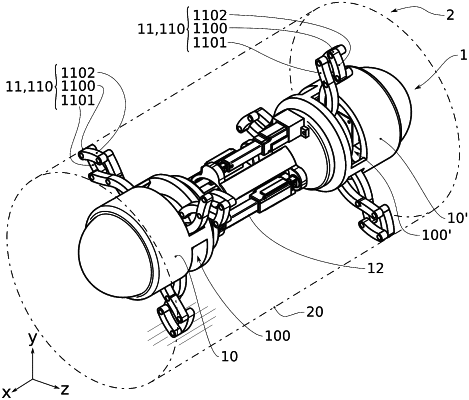| CPC F16L 55/34 (2013.01) [B25J 9/16 (2013.01); F16L 2101/10 (2013.01); F16L 2101/30 (2013.01)] | 14 Claims |

|
1. A robot for exploring a conduit, the robot comprising a first frame and a second frame, the first frame and the second frame each comprise a bearing module provided with a plurality of articulated arms, each articulated arm comprising a bearing portion that can be applied against a wall of the conduit, the bearing portion being able to be displaced by a movement of an articulated arm,
each bearing module being configured to switch alternately from a bearing portion engaged configuration into a bearing portion disengaged configuration, each articulated arm being deployed further in said engaged configuration than in said disengaged configuration,
each bearing module is further configured such that the articulated arms are disposed in a plane perpendicular to a longitudinal axis of at least one of either the first frame or the second frame, and such that the articulated arms are capable of at least partially moving between said engaged configuration and said disengaged configuration, via a rotational motion, through at least one angular sector, about an axis parallel to the longitudinal axis of the at least one of either the first frame or the second frame,
each articulated arm comprises a first rod and a second rod,
wherein that the first rod is configured to be articulated such that it rotates with the second rod in a direction parallel to the longitudinal axis of the at least one of either the first frame or the second frame, by at least a distal pivot and a proximal pivot, and
wherein the first rod and the second rod each comprise a distal portion and a proximal portion, the distal portion and the proximal portion being articulated such that they rotate by an intermediate pivot, in a direction parallel to the longitudinal axis of the at least one of either the first frame or the second frame, the intermediate pivot being located between the distal pivot and the proximal pivot, along each of the first rod and second rod.
|